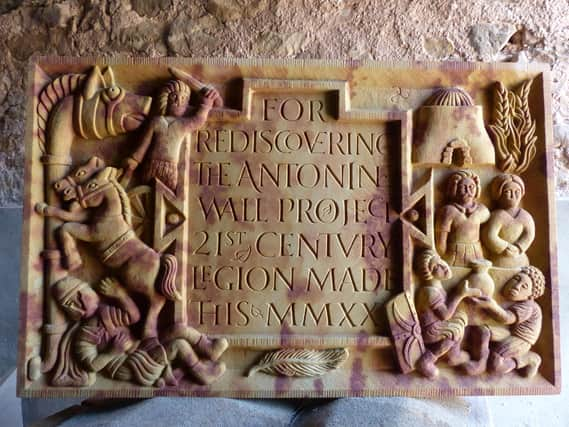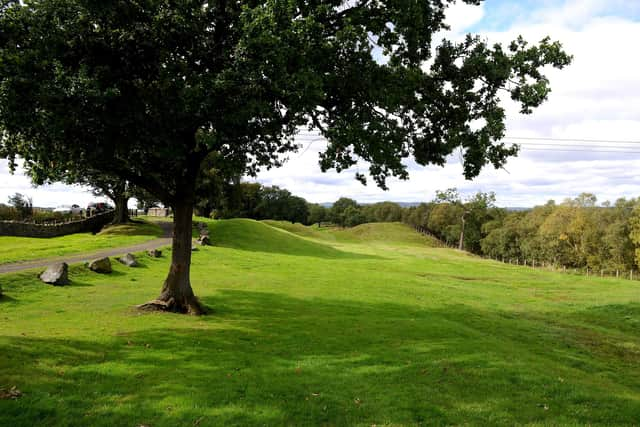Northern warriors who fought the Romans in Scotland to be celebrated at Antonine Wall


The newly-carved distance stone will “flip” the narrative of the Roman Empire’s most northerly frontier and represent the Iron Age people who both lived alongside the Roman soldiers and resisted their occupation of Scotland, which was then known as Caledonia.
The stone will be placed at Cow Wynd in Falkirk close to the line of the Antonine Wall, which was built from around 140 AD and spanned 37 miles between the Firth of Forth and the Firth of Clyde.
Advertisement
Hide AdAdvertisement
Hide AdFeaturing several references to Iron Age Scotland, the stone includes a depiction of the Deskford Carnyx, a slim trumpet-like instrument that was used to rouse fighting spirit ahead of battle.


Northern warriors attacking Roman soldiers using a horse-drawn chariot, as was the case at the Battle of Mons Graupius around AD83, are also depicted along with a piece of tartan and a broch, a type of stone tower dwelling that was unique to Scotland at that time.
Dr Louisa Campbell, fellow in archaeology at Glasgow University and consultant on the Rediscovering the Antonine Wall project, said: “This has been a great opportunity to explore new dynamics and different narratives of the Roman presence in Scotland.
“The stonemasons have done an incredible job in drawing out these wider narratives and looking at the role the Iron Age population played at the time of the Antonine Wall.
“We were really trying to flip the narrative and tell the wider story.”
The stone was created by stonemasons Luke Batchelor and Jo Crossland.
Dr Campbell said the original distance stones, which marked out the construction progress of the Roman Legions, were placed along the wall and formed part of the “propaganda artillery” of the Roman Empire.
She added: “They celebrated the conquests of the Roman army and their purpose was really to reinforce the subjugation of the local population, who were depicted as weak powerless people.
Advertisement
Hide AdAdvertisement
Hide Ad“However, what we know from the historic sources is that the Northern warriors who fought at Mons Graupius were fighting the Romans using horse-drawn chariots.
“We are accustomed to seeing well represented scenes of Roman cavalry riding down these Northern warriors but what we wanted to do was understand the local perspectives rather than focus on the dominating Roman narrative.”
The Battle of Mons Graupius was fought somewhere in the North East with Roman accounts suggesting that up to 10,000 Northern warriors were killed in the mass clash, although some doubt exists over the accuracy of the figures.
The Rediscovering the Antonine Wall project is a collaboration of the five local authorities through which the Wall runs – West Dunbartonshire, Glasgow City, East Dunbartonshire, North Lanarkshire and Falkirk – along with Historic Environment Scotland, and the core work is funded by the National Lottery Heritage Fund and LEADER.
Four replica distance stones have also been created as part of the project and will be placed close to the line of the wall in due course.
Dr Campbell said: “The project is intended to reach out to local communities and enable them to celebrate and discover the Antonine Wall in meaningful ways to them. Some want to regenerate local spaces, while others have been running community based events .
“I think people have really started to recognise the significance of the wall and are really good at seeing these broader narratives that surround it.”
Dr Campbell said another feature of the new distance stone was English text rather than the “very prescriptive abbreviated Latin” found on the originals with hopes this will further open up the monument to local people.
Advertisement
Hide AdAdvertisement
Hide AdBreakthrough research by Dr Campbell earlier found that the distance stones of the Antonine Wall were originally painted in vivid colours with red used to paint both the cloaks of Roman officers and drops of blood of their captives with shades of ochre used to build up skin tones.
At its peak, up to 7,000 men were stationed along the Antonine Wall in seventeen forts and several smaller enclosures. It was abandoned by the Romans after around 20 years.